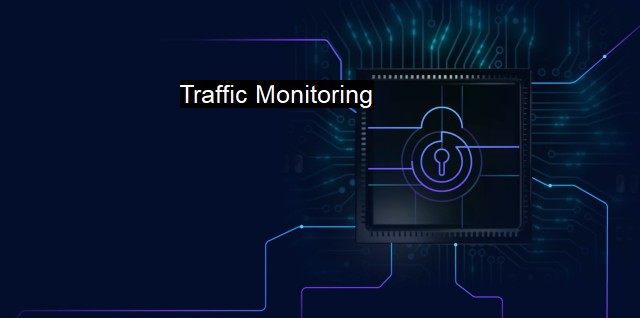What is Traffic Monitoring?
The Crucial Role of Traffic Monitoring: Safeguarding Networks from Cyber Threats with Packet Capture and Flow Data Analysis
Traffic monitoring in the context of cybersecurity and antivirus refers to the systematic observation and scrutiny of network operations, focusing on data packets moving in and out of a system or an entire network. This technology plays an essential role in ensuring the security, integrity, availability, and confidentiality of data.Traffic monitoring analyzes the flow of information across different corners of a network towards identifying and reacting to any abnormalities. traffic monitoring helps anticipate, discover, and prevent threats before they can result in substantial harm to a system. It functions as a sophisticated burglar alarm and a proactive defense measure.
The scope of traffic monitoring is vast. It extends from studying the size, origin, destination, time, and content of the data packets to identifying unusual network trends. That includes patterns of traffic such as sudden spikes, unusual lulls, or creation of large data files. Collecting this data helps in identifying potential malicious activities and keeping a close eye on network vulnerabilities.
One of the common methods used in traffic monitoring is mirroring ports. The network’s physical ports produce an exact copy of each packet that passes through it. These copies are then forwarded to a security tool for analysis. As the monitoring is done on the mirror image of the traffic, it ensures zero interference with the network's normal functioning.
Deep packet inspection (DPI) digs deeper into the data packet as it scrutinizes the packet's headers and payload. This aids in identifying any suspect data hidden deep within the packet. DPI can help in discovering numerous threat types, including intrusion attempts, viruses, Trojans, and other forms of malware, thereby supplementing its antivirus capacities.
In the broader sense, traffic monitoring is powered by advancements such as Artificial Intelligence (AI), Machine Learning (ML), and data mining. Combined, these quantities of data allow algorithms to not only recognize recurring patterns indicating threats but also to predict future attacks and vulnerabilities.
Traffic monitoring sorts, categorizes, and labels network traffic, empowering organizations with precious real-time information. This information can expose illegal activities like hacking, phishing, Distributed Denial of Service (DDoS) attacks, or exploit attempts.
Traffic monitoring enhances profiling and network mapping capabilities. The processed data can be prearranged to provide diverse visions and situational awareness of network habits. These insights can offer a chance for cybersecurity teams or antivirus software developers to constantly evolve their security protocols.
Notwithstanding its vast capabilities, traffic monitoring is also associated with some challenges. High amounts of data traffic can saturate monitoring tools or overwhelm them with false positives. encryption and an evolving threat landscape can create difficulties to traffic monitoring efforts.
Nonetheless, traffic monitoring remains integral to cybersecurity. It's an area that requires the right blend of people, processes, and technologies. With it, individual users and businesses can navigate cyberspace confidently, knowing that their data remains secure from potential threats and malware. Antivirus programming often employs traffic monitoring as an additional safeguarding layer for improved detection and remediation of cyber threats.
Traffic monitoring is a cornerstone of a comprehensive cybersecurity strategy. It enables organizations to protect themselves from threats proactively while promoting the stability and smooth functioning of their networks. Despite its challenges, traffic monitoring along with effective antivirus functionalities is a necessity in preserving the robustness of our data-rich digital world.

Traffic Monitoring FAQs
What is traffic monitoring in the context of cybersecurity?
Traffic monitoring in cybersecurity refers to the practice of analyzing network traffic data to detect potential cyber threats and attacks. By analyzing incoming and outgoing traffic, security teams can identify unusual patterns, anomalies, or suspicious activity that can indicate a security breach.What are some common tools used for traffic monitoring in cybersecurity?
There are various tools and solutions available for traffic monitoring in cybersecurity, such as firewalls, intrusion detection and prevention systems (IDPS), network traffic analyzers, and security information and event management (SIEM) systems. These tools can help security teams monitor network traffic data, identify potential threats, and take action to prevent or mitigate them.Why is traffic monitoring important for antivirus protection?
Traffic monitoring is important for antivirus protection because it allows security teams to detect and block malicious traffic that could compromise a system or network. Antivirus solutions typically rely on signature-based detection to identify known malware, but traffic monitoring can help detect new and unknown threats that may not be detected by traditional antivirus software. By monitoring traffic data, security teams can identify suspicious activity, such as unusual network traffic or suspicious file downloads, and take appropriate action to prevent a security breach.What are some challenges of traffic monitoring in cybersecurity?
Traffic monitoring in cybersecurity can be challenging due to the large volume of network traffic data that needs to be analyzed, the complexity and diversity of network environments, and the increasing sophistication of cyber threats. Effective traffic monitoring requires robust tools, skilled personnel, and advanced analytics capabilities to detect and respond to potential threats in real-time. Moreover, privacy concerns and regulatory requirements may also pose challenges for traffic monitoring, as security teams need to balance the need for security with the protection of user data and privacy.| | A | | | B | | | C | | | D | | | E | | | F | | | G | | | H | | | I | | | J | | | K | | | L | | | M | |
| | N | | | O | | | P | | | Q | | | R | | | S | | | T | | | U | | | V | | | W | | | X | | | Y | | | Z | |
| | 1 | | | 2 | | | 3 | | | 4 | | | 7 | | | 8 | | |||||||